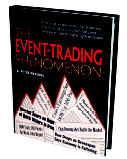.jpg)
Follow
Us:    
|
January 28, 2017
Join Online Trader's Summit for
8 Hours of FREE Online Training
Sponsored by Technical Analysis
of Stocks & Commodities
Wendy Kirkland would like to personally invite you to the upcoming Online Trader's Summit. She will be presenting "Proprietary Indicators Pinpoint Market Trades."
We're very excited about this event, check out all the great presenters and complimentary offers!
Don't Miss It...
Click Here to Register
10:00 am ET - Steve Bigalow:
How to Identify Profit - Making Opportunities with Trend Analysis
11:00 am ET - Rob Booker:
Using Missed Pivots to Ride the Biggest Trends
12:00 pm ET - Wendy Kirkland:
Proprietary Indicators Pinpoint Market Trades
1:00 pm ET - Vince Vora:
Voracity - The Most Powerful Way to Safely Trade Today's Markets
2:00 pm ET - Scott Brown:
Finding the Right Strategy for You
3:00 pm ET - Fausto Pugliese:
How to Avoid Dumb Money Mistakes
4:00 pm ET - Jonathan Rose:
Swinging for the Fences – How to Find and Trade Inexpensive Options
5:00 pm ET - Kan Calhoun: How to Trade Winning Gaps & Breakouts
6:00 pm ET - Jeff Gibby:
Q & A Session
Many presenters are offering bonus items to everyone who registers.
If you are unable to attend the event, you can still REGISTER HERE to receive the recording and bonuses!
Also, Tomorrow, January 26th at 3:30 pm CST, Join Kerry "Dr. Duke" Given for a FREE educational webinar on options trading!
Space is Limited...
Sign Up Now!

|
|
The Event-Trading system was developed by Peter McKenna, a journalist with more than 20 years of experience reporting on the stock market. As a reporter for Investor’s Business Daily, he watched in horror as thousands of small investors lost their money when the tech bubble crashed. He went looking for a better system, a system that would put the power back in the hands of the small investor and keep the so called professionals at bay. The system he found was the Event Trading Phenomenon.
 |
Technical and Fundamental Strategies to Profit from Market Swings

The Event-Trading Phenomenon introduces a new trading system that is destined to become the most popular trading strategy ever devised. It offers substantial profits with minimal risk.
Under the event trading rules, you will trade only when a news event makes market direction highly predictable for just one day. And when the right news event occurs, event traders trade index options rather than stocks. They do not have to be stock pickers and they can earn large, one-day profits that would not be possible with stocks. This strategy keeps market risk extremely low.
The event system is not a simple-minded, knee jerk reaction to good and bad news. It is a highly disciplined strategy that keeps investors out of the market unless the right news is released under the right market circumstances. Good news that is released when the market is greatly overbought, for example, will not cause a large upward move. The system was developed by Peter McKenna, veteran market reporter. He outlines his strategy with an easy-to-use color-coded system.
Trading With
The Event-Trading Phenomenon
|
|

Better
Business Bureau
 |
|
Click on authors name
to learn more
|
| |
|
|
Inside Trading this week brings you an article from Peter McKenna. He reviews index options through the eyes of an event trader.
Then, Lee Gettess tells us what he expects from both the S&P and bond markets for the coming week.
Next, Chris Verhaegh explains what “gaps” are and how they get filled.
Last, Wendy Kirkland brings us her Prime Entry Profits (PEP) Rally Newsletter.
Enjoy!
Adrienne LaVigne
TradeWins Publishing
 |
|
Event Trading: Index Options
by
Peter McKenna
The following
is an excerpt from Peter McKenna's The Event-Trading Phenomenon
Imagine that you are an event trader, and that day after day sellers have dominated the trading action, driving the market to greatly oversold levels. Recent economic indicators have been negative, which means the economy is crawling along.
Now imagine that before the bell, Microsoft announces spectacular earnings and say its future earnings appear strong as well. The market is oversold and there are no prevailing conflicts or uncertainties. The market will very likely go up, perhaps way up.
It’s time for you to act, to jump into an index call option. The first step is to decide which call to buy. If all goes well, all the indexes will go up and you will earn a profit no matter which index you choose. In my opinion, however, some indexes are better than others for event traders. I rank them as follows, beginning with the best:
S&P 500 Index (SPX)
S&P 100 Index (OEX)
Dow Jones Industrial Index (DJX)
NASDAQ 100 Trust (QQQ)
NASDAQ 100 (NDX)
The reasons for these rankings are based on safety concerns rather than potential profits. Options based on the Nasdaq 100, ranked last on my list, are powerful. They can make you a lot of money in a short amount of time. But when the market turns against you, these contracts are wicked, and the losses can be staggering. Here’s why.
The price you pay to buy an index option is called a premium. Premiums are determined by a computer-driven formula that measures, among other variables, the historic volatility of all stocks in an index and the time left until expiration. This formula is called Delta.
The Nasdaq 100 index is comprised of 100 highly volatile stocks traded mainly by speculators and day traders. It can register large gains and losses in a short amount of time. This means the calls and puts based on this index can also register large gains and losses in a short amount of time. If you are holding a Nasdaq 100 call when the index goes way up, you can make a considerable amount of money. Conversely, if you are holding a put when the index goes way down, you can also make a considerable amount of money.
Because they offer this potential for making large gains, Nasdaq 100 options are dangerously expensive. At the time of this writing, the Nasdaq 100 Index was trading at 1025. The August 1025 call, an at-the-money contract, was trading at $74.80, or $7,480 per contract.
Event Trading: Index Options
|
Lee
Gettess' Market Sense
by Lee Gettess
Lee
Gettess is a top trader who is excited
to bring you his video newsletter.
Each week, Lee will share his predictions
on what he anticipates from the bond
and S&P markets.
Watch
Video
|
Gaps – How They Fill
by Chris Verhaegh
The following
is an excerpt from Chris Verhaegh's The PULSE System
What do I mean by a gap? Below is a great chart that shows gaps and how they fill. Notice how the price “gaps” down between Sept 10 and Sept 11. Then, only a few days later, the price reverted back and “filled” the gap. Meaning the price came back to where it was before the gap. If we see a gap up, instead of a gap down, then that gap is filled when the price comes back down to where it was before the gap.
Not all gaps fare as neat and tidy as the one on this chart. Some gaps may take months or even years to fill! In very rare cases, like a buyout or a bankruptcy, some gaps never get filled. As a general rule, though, most gaps fill over time. The way to play them is to buy an option in the opposite direction of the gap.
When expecting gaps to fill, we often don’t favor the short time frame. Look again at the gap in mid March; it didn’t fill until the stock gapped again in the opposite direction almost a month later. If we played a gap like this using Weekly options, we would be disappointed.
So how do gaps happen? Understand the stock market opens at 9:30 AM EST and closes 6 ½ hours later at 4:00 PM EST. The first trade of the day is known as the “opening trade”. The last trade of the day is known as the “closing trade”. Under normal circumstances, a stock should open for trading at roughly the same price where it closed the previous trading day. The key words in the last sentence are “normal circumstances”. Gaps are not normal. That’s whey we find them so important.
Normally stocks will start off where they left off. But in the case of a significant event like an Earnings release, there may be information in that event that changes people’s opinion of the stock dramatically. This new information may come as a shock to the market. After-hours sentiment then could drastically swing a stock’s price away from the closing price, so when the market opens in the morning that stock opens with a “gap” – up or down – from the previous night’s close.
Bad news may cause potential buyers to change their minds about buying. It could also change the minds of current owners about holding on to the stock. Good news may cause potential buyers to take action and it may calm current owners who had been considering selling. News, good or bad, can change everyone’s opinion. This changing of opinion can be so intense that bad news causes a stock to open much lower than its previous close: a gap down in price.
Gaps – How They Fill
|
Prime Entry Profits (PEP)
by Wendy Kirkland
The following is an excerpt from Wendy Kirkland's Prime Entry Profits
Every day Wendy shares her “Prime Entry Profits” (PEP) Rally Newsletter. The following is her thought for the week, along with what she expects this week in trading.
Thought for the Week: To find heaven on Earth is to live your life at the same level or frequency as you're being, as you are living in pure love and joy. If you aren't experiencing your best-life, raise your frequency now, express joy every day and life will conform to your highest expectations.
Today in Trading: The Dow started the day up a few dollars and closed very close to the 20K mark. It didn't make it today, but it very well could hit 20K this week. The uptrend remains intact, but the high number of distribution days still means it is fragile. A few of the days are due to expire before long as they hit the 25 day mark from their creation.
This is a busy earnings week. Remember to check earnings dates on your trade candidates.
MRK- Merck & Co - P3
MYL- Mylan - P3
REGN- Regeneron - P3
TEVA- Teva - P3
DAL- Delta Airlines- P3
To Learn More Click Here
|
|